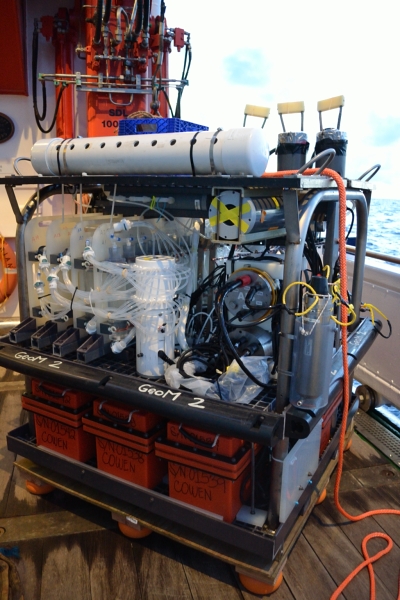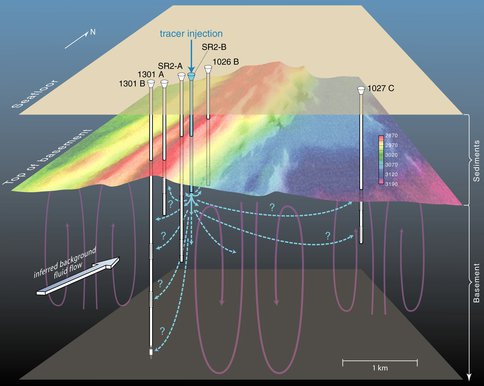2012 Annual Science Report
 University of Hawaii, Manoa
Reporting | SEP 2011 – AUG 2012
University of Hawaii, Manoa
Reporting | SEP 2011 – AUG 2012
Interdisciplinary Studies of Earth's Seafloor Biosphere
Project Summary
The remote deep sediment-buried ocean basaltic crust is Earth’s largest aquifer and host to the least known and potentially one of the most significant biospheres on Earth. CORK observatories have provided unparalleled access to this remote environment. They are enabling groundbreaking research in crustal fluid flow, (bio)geochemical fluid/crustal alteration, and the emerging field of deep crustal biosphere
Project Progress
Project members participated in an expedition to North Pond on young flanks of the Mid-Atlantic Ridge (R/V Merian, with ROV Jason; April 11 to May 9, 2012). Cowen, graduate student Lin, and research associate Hsieh loaded the ship and set up the gear; Lin and Hsieh represented Cowen and UHNAI on this international expedition. The expedition employed a remotely operated vehicle (ROV Jason) and specialized pumping and sampling systems developed at UH for the first sampling of cool hydrothermal fluids circulating within the ocean basaltic crust via two new seafloor (CORK) observatories installed by the Integrated Ocean Drilling Program in fall 2011. Two new generation seafloor instrument (GeoMICROBE) sleds (Figure 1) were deployed to the seafloor (attached to new North Pond CORKs, Figure 2) for 20-month time series deployment. Deep crustal fluids will be pumped from several hundreds of meters below the seafloor to special acid-cleaned and sterile samplers at the seafloor. Samples will be analyzed for a suite of geochemical and microbiological (e.g., biomass, molecular diversity, and metabolic rates) parameters.
We have also recently had an exciting science breakthrough in another component of our Deep Biosphere Projects involving the first ever large-scale (time and space) tracer injection experiment in the ocean crust. Over the past 10 years we have established a three-dimensional, subseafloor, IODP observatory network in the northeastern Pacific Ocean. We finally were able to initiate (injected dissolved, gas and colloidal – fluorescent microspheres – tracers) the large-scale, large-term cross-hole experiments in August 2010 (Figure 3). Six monitoring wells (CORKs) were equipped with continuous (OsmoSamplers) and/or intermittent samplers (GeoMICROBE sleds). The colloid tracers represent proxies for microorganisms, and their recovery at monitoring holes should provide unprecedented insight into the mobility and origin of microorganisms within this remote biosphere. Analyses of these samples for evidence of tracer breakthrough is ongoing; however, recent data confirms that the microspheres have indeed been recovered in the monitoring wells. These data result in preliminary transport rates of greater than 8 m day-1 for bacteria/archaea-sized particles through the fractured medium of ocean crust. The data also confirm the tremendous sensitivity of our tracer recovery and analyses methods, of <0.02 microspheres ml-1 (Figure 4).
To significantly move the deep biosphere research community forward, UHNAI Co-PI Cowen is leading a community effort to connect the CORKs to NEPTUNE-Canada’s Cabled Network Observatory System in the Northeast Pacific. Extending the power and communication/data transmission of the Neptune to the new Juan de Fuca Ridge flank CORKs is the exciting, logical, and cost effective future for long-term observations of subseafloor hydrogeological systems, providing infrastructure for continuous hands-on monitoring and active experimentation on this most remote but dynamic environment. NEPTUNE-Canada has agreed to fund a community workshop prior to the fall 2012 AGU meeting (Workshop on NEPTUNE-CORK Observatory Connections: Juan de Fuca Ridge Flanks; December 2, 2012, W Hotel, San Francisco). Program managers for NEPTUNE-Canada and U.S. NSF express enthusiasm for this proposal and are providing advice as to how to best proceed. We anticipate submittal of formal proposals to NEPTUNE and NSF by February 2013.

Two new generation seafloor instrument (GeoMICROBE) sleds (Figure 1) were deployed to the seafloor (attached to new North Pond CORKs, Figure 2)
Over a period of 20 months, deep crustal fluids will be pumped from several hundreds of meters below the seafloor to special acid-cleaned and sterile samplers at the seafloor. Samples will be analyzed for a suite of geochemical and microbiological (e.g., biomass, molecular diversity, and metabolic rates) parameters
During this reporting period, six monitoring wells (CORKs) were equipped with continuous (OsmoSamplers) and/or intermittent samplers (GeoMICROBE sleds). This should provide unprecedented insight into the mobility and origin of microorganisms within this remote biosphere
Microphotograph of 1 m diameter fluorescent microsphere recovered from borehole 1301A with GeoMICROBE as part of Tracer Transport project. Image taken under epifluorescence microscope
Publications
-
Baker, E., Chadwick, W., Cowen, J., Dziak, R., Rubin, K., & Fornari, D. (2012). Hydrothermal Discharge During Submarine Eruptions: The Importance of Detection, Response, and New Technology. oceanog, 25(1), 128–141. doi:10.5670/oceanog.2012.11
-
Cowen, J. P., Copson, D. A., Jolly, J., Hsieh, C-C., Lin, H-T., Glazer, B. T., & Geoffrey Wheat, C. (2012). Advanced instrument system for real-time and time-series microbial geochemical sampling of the deep (basaltic) crustal biosphere. Deep Sea Research Part I: Oceanographic Research Papers, 61, 43–56. doi:10.1016/j.dsr.2011.11.004
-
Fisher, A. T., Tsuji, T., Petronotis, K., Wheat, C. G., Becker, K., Clark, J. F., … Jannasch, H. (2012). IODP Expedition 327 and Atlantis Expedition AT 18-07:Observatories and Experiments on the Eastern Flank of the Juan de Fuca Ridge. Scientific Drilling, None(13, April 2012), None. doi:10.2204/iodp.sd.13.01.2011
-
Fornari, D., von Damm, K., Bryce, J., Cowen, J., Ferrini, V., Fundis, A., … White, S. (2012). The East Pacific Rise Between 9°N and 10°N: Twenty-Five Years of Integrated, Multidisciplinary Oceanic Spreading Center Studies. oceanog, 25(1), 18–43. doi:10.5670/oceanog.2012.02
-
Jungbluth, S. P., Grote, J., Lin, H-T., Cowen, J. P., & Rappé, M. S. (2012). Microbial diversity within basement fluids of the sediment-buried Juan de Fuca Ridge flank. ISME J, 7(1), 161–172. doi:10.1038/ismej.2012.73
-
Lin, H-T., Cowen, J. P., Olson, E. J., Amend, J. P., & Lilley, M. D. (2012). Inorganic chemistry, gas compositions and dissolved organic carbon in fluids from sedimented young basaltic crust on the Juan de Fuca Ridge flanks. Geochimica et Cosmochimica Acta, 85, 213–227. doi:10.1016/j.gca.2012.02.017
-
Resing, J. A., Rubin, K. H., Embley, R. W., Lupton, J. E., Baker, E. T., Dziak, R. P., … Thomas, H. (2011). Active submarine eruption of boninite in the northeastern Lau Basin. Nature Geosci, 4(11), 799–806. doi:10.1038/ngeo1275
- Boettger, J., Amend, J.P., Hensche, M., Lin, H. & Cowen., J.P. (In Press). Energetics of microbial metabolism in the subseafloor basement ecosystem at the Juan de Fuca Ridge. Geochimica et Cosmochimica Acta.
-
PROJECT INVESTIGATORS:
-
PROJECT MEMBERS:
James Cowen
Project Investigator
Brian Glazer
Co-Investigator
Michael Rappe
Co-Investigator
Jan Amend
Collaborator
Michael Mottl
Collaborator
Robert Bowers
Postdoc
Alberto Robador
Postdoc
Sean Jungbluth
Graduate Student
Huei-Ting Lin
Graduate Student
-
RELATED OBJECTIVES:
Objective 4.1
Earth's early biosphere.
Objective 4.2
Production of complex life.
Objective 5.1
Environment-dependent, molecular evolution in microorganisms
Objective 5.2
Co-evolution of microbial communities
Objective 5.3
Biochemical adaptation to extreme environments
Objective 6.1
Effects of environmental changes on microbial ecosystems
Objective 6.2
Adaptation and evolution of life beyond Earth
Objective 7.1
Biosignatures to be sought in Solar System materials
Objective 7.2
Biosignatures to be sought in nearby planetary systems


